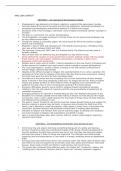KING LEAR CONTEXT
SECTION 1 – An overview of the historical context
Shakespeare's age believed in imminent cataclysm, expected the apocalypse. Sunday
sermons spoke of the end of the world and the Last Judgement, visionaries predicted it in
pamphlets and theologians and painters depicted it in words and images.
Jacobeans lived in fear of plague, starvation, social collapse and bloody catholic outrages or
invasion.
The play is a microcosm of a society disintegrating.
The Armageddon wreckage portrayed in the last scene mirrors what some Jacobeans saw
as they looked around them.
Though the setting is ostensibly pagan, the moral bases by which the audience judged
what it saw are biblical.
Elizabeth, I died in 1603 and King James VI of Scotland became James I of England. King
Lear was written between 1603 and 1606.
The new king, ruling until 1625, was of a Scottish family, the Stuarts and they were a
dynastic disaster.
None of them were an effective king and kingship is a key theme in Lear.
James shirked the routines of work government involved, disliked contact with his people,
drank heavily, was extravagant, impulsive and tactless, constantly in debt, and in
perpetual conflict with parliament.
Religion was a major area of conflict. Catholic opposition to the new Church of England and
Puritan desires for freedom from tight central control created a constant battleground.
The 'new individualism', another context, emerges in the self-centred ruthlessness of
Goneril, Regan, Edmund and Oswald.
Despite all the official changes to religion, the essential beliefs in sin, virtue, salvation, the
centrality of Christ and the ubiquity of the Devil (the idea that he was everywhere, looking
to tempt man) were the same as they had always been.
One feature of the period was the unceasing rise in prices, particularly of food, bringing
about a decline in the living standards of the poor, for wages did not rise. Rising numbers
of poor put greater burdens on Poor Relief in small, struggling rural communities and
added to the elite's fear of some monumental uprising of the disenchanted.
Economic difficulties, poverty, social conflict, religious dissent and political tensions
relating to the role and nature of monarchy and the role and authority of parliament all
remained unresolved.
Emerging problems are ignored or masked because the ruler disallows discussion of the.
Elizabeth, for example, passed several laws making it treason to even discuss who might
succeed her. Such a ruler's death exposes the true state of things. Many of these features
are reflected in the contexts of Lear.
The plan to 'divest' himself of rule and the love test expose flawed thinking and suggest his
decision making in general may be faulty. In exposes and activates the fault lines in his
family. Lear's behaviour raises the question, often asked in James' time, of the place that
councillors, personal advisors and parliament should have in making state decisions.
Attitudes to religion and freedom from church authority began to develop into resistance
and science began to displace old superstitions and belief in magic.
Lear is a typical Jacobean play, dark, cynical, satirical, violent, psychological, exploring
character and motive.
SECTION 2 - The Elizabethan world order: from divinity to dust
Strict hierarchy and organic harmony (everything being part of a whole and having a
function to perform) were the overriding principles of the broad orthodox background to
how the audience thought their universe was struct red, how they saw God and religion
and how their place in order of things was organised. The disorders and disharmonies
upsetting roles and expectations in Lear make It a deeply unsettling threat to established
order.
Everyone was clear where they were in the universal order, the 'Great chain of being'. Man
was inferior to God, but superior to all animals, birds, fish, plants and minerals. God ruled
heaven, kings ruled on Earth and Fathers ruled families, like God at home.
The human link contained three different ranks: the 'better sort' (monarchs, nobles), the
'middling sort' (merchants, farmers) and the 'baser sort' (artisans, peasants, beggars).




